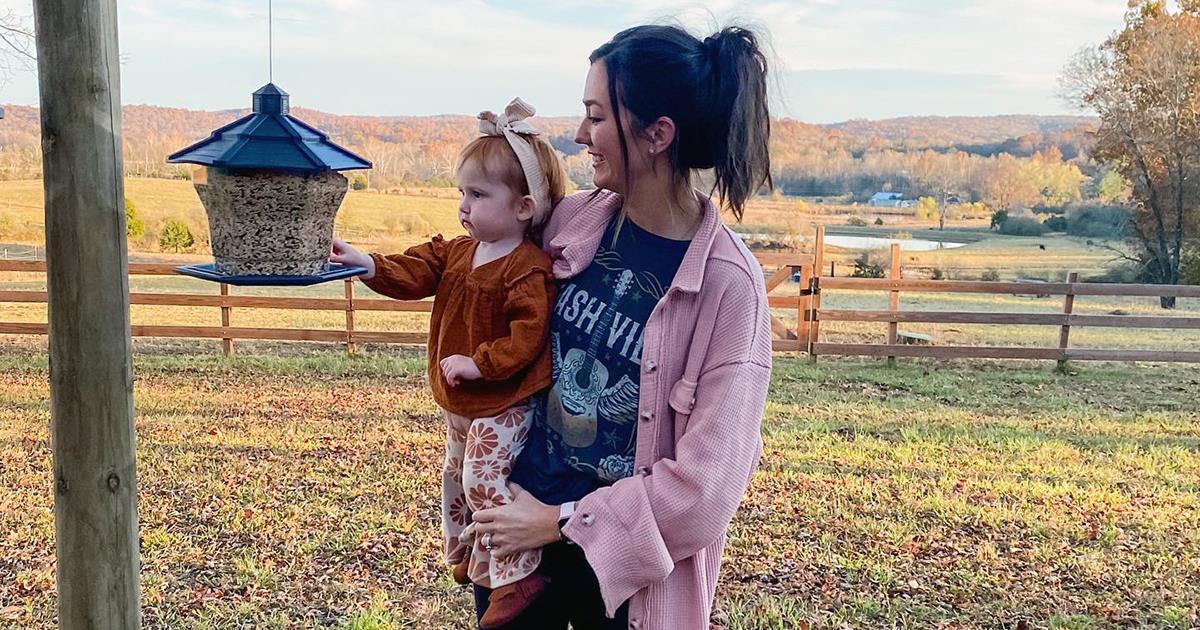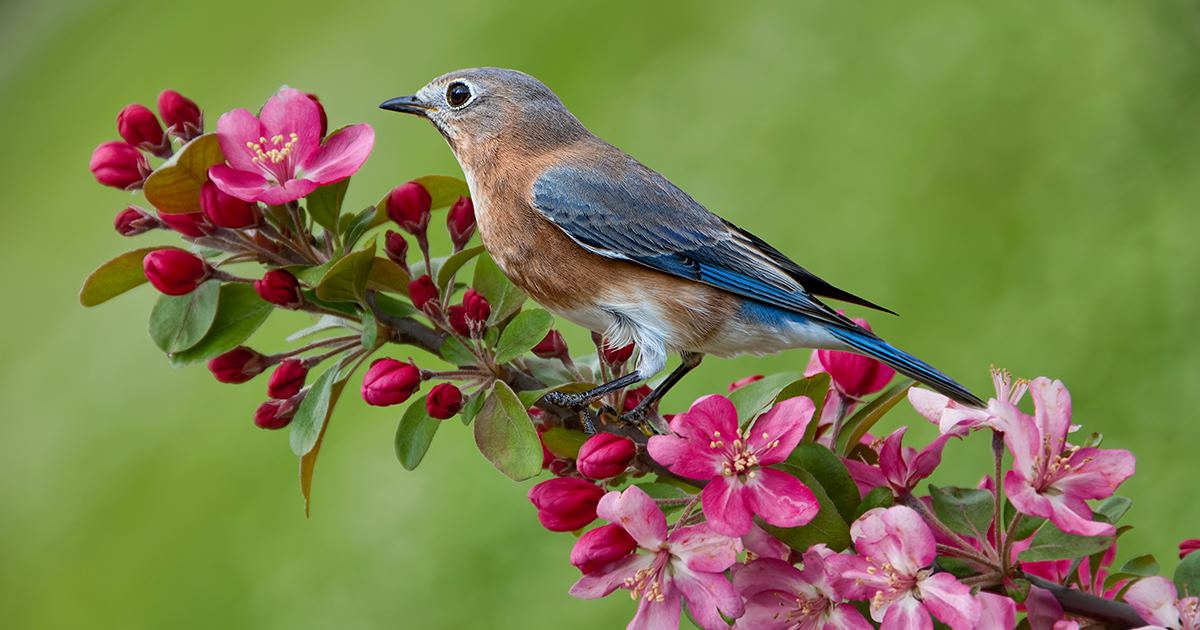Choosing the Best Type of Bird Feeder
As your birdwatching hobby grows, you'll find yourself wondering which types of bird feeders to use to attract your favorite species. Thankfully, there are several styles to explore! One thing to keep in mind — placing multiple feeders in your yard will attract a greater variety of birds to admire while reducing overcrowding.
- Hopper Bird Feeders
- Tube Bird Feeders
- Platform Bird Feeders
- Suet Bird Feeders
- Ground Feeding Wild Birds
- Nectar Feeders
- Birdwatching Tips and Tricks
- Elevate Your Birdwatching Hobby

Attract the widest variety of wild birds with a hopper feeder.
Hopper Bird Feeders
A hopper feeder looks like a small house with a roof to keep seed dry. Seed is added through the top, which uses gravity to keep the feeding area at the base full of food. Birds that like to perch while eating enjoy hopper feeders. Hopper feeders are good for seed mixes with both big and small pieces.
Large Hopper Feeders
If you have ample yard space, choose a larger hopper bird feeder such as the Pennington Cedar Nature's Friend Bird Feeder made of Eastern Red Cedar. It's naturally weather-resistant and easy for beginning birders to fill.
Recommended seed blend: Try offering Pennington Feeding Frenzy Woodpecker Nut & Fruit Double Nut Blend Wild Bird Food made with sunflower chips, cherries, mixed nuts and more.
Birds to watch: This type of feeder and wild bird food blend tends to attract Hairy Woodpeckers, Blue Jays, chickadees, nuthatches, titmice and Red-bellied Woodpeckers.
Small Hopper Feeders
If you have a more compact area for birdwatching, like a small patio, try adding a starter-size hopper feeder to enhance your hobby. The Pennington Cedar Dinette Bird Feeder, made from Eastern Red Cedar, resists weather and attracts colorful songbirds.
Recommended seed blend: Get started by filling the small hopper feeder with Feeding Frenzy Cardinal & Songbird Suet Nugget Blend. Your bird visitors will enjoy the peanut suet nuggets, raisins, black oil sunflower seeds and other high-energy ingredients.
Birds to watch: Offering this nugget blend with this small hopper feeder tends to entice Northern Cardinals, chickadees, Carolina Wrens, Downy Woodpeckers, Pine Warblers and other songbirds.
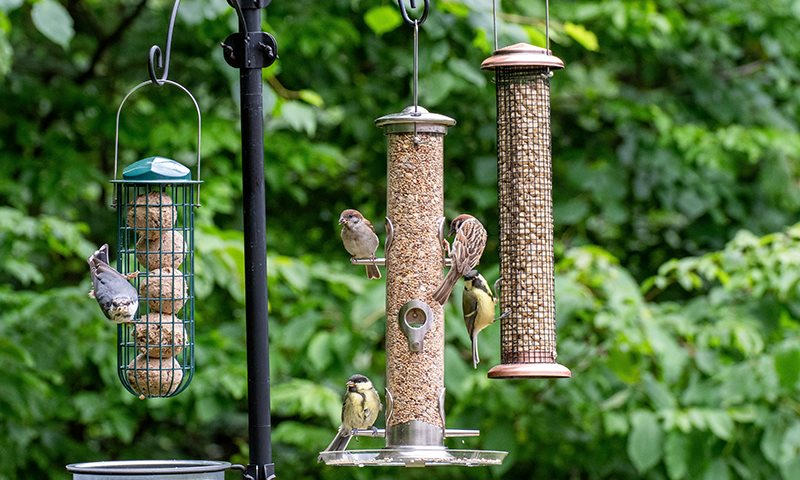
Tube feeders come in different sizes to attract different types of birds.
Tube Bird Feeders
Long, vertical tube-shaped feeders have small openings along their length to allow multiple birds to peck at the food. Plus, they're easy to hang from a shepherd's hook. Usually, tube feeders hold smaller food and seed options. Birds that like to cling (like they do on vertical tree trunks) enjoy eating from a tube feeder.
Large Tube Bird Feeders
Select a large tube if you want to attract large birds, don't want to fill the feeder as often or have larger pieces of food to offer. For example, the Pennington Feeding Frenzy Wire Feeder has openings large enough for birds to snatch suet nuggets, sunflower seeds and peanuts.
Recommended seed blend: Try filling your large tube feeder with Pennington Feeding Frenzy Woodpecker Delight Suet Nuggets featuring pieces of peanuts, beef suet, oats, raisins and more.
Birds to watch: This food and feeder combo will bring all sorts of woodpeckers to your yard, including Red-bellied, Hairy and Downy. You might also attract Northern Flickers, cardinals and titmice.
Small Tube Feeders
Smaller tubes work perfectly in quaint garden spaces. They tend to hold smaller seeds and attract petite birds. Some small tube feeders feature special niger seed feeding holes for finches. Consider the Pennington Squirrel Resistant Feeder in Bronze if you need to deflect squirrels from your bird feeding area with the chew-proof hanging cable and six seed ports for birds to explore.
Recommended seed blend: Fill your small tube-style feeder with Pennington Feeding Frenzy Finch Favorites Tube Feeder Blend. It offers thistle seed, sunflower chips, white proso millet and more bite-sized food items best suited to small beaks.
Birds to watch: This feeder and seed combo brings Purple Finches, goldfinches, chickadees, Fox Sparrows, House Finches and other songbirds for a meal.

A platform or tray feeder offers an unobstructed view of your bird friends.
Platform Bird Feeders
These platform, or tray, feeders attract the widest variety of birds and offer the best unobstructed views. But they also attract squirrels. Sometimes birds also prefer an elevated, flat surface so they can scratch through the seed blend and find their favorite morsels away from ground-dwelling predators. The Pennington Cedar Hanging 2 in 1 Bird Bath/Feeder is a tray-style feeder that easily hangs from a deck railing, the Pennington Feeder Pole Plus or a shepherd's hook.
Recommended seed blend: Add Pennington Feeding Frenzy Bits & Chips No Mess Blend to your platform feeder. This mix features peanut bits and sunflower chips — and no seeds with hulls or shells to make a mess on your patio or deck.
Birds to watch: This feeder and food combo will attract a variety of birds, including Downy Woodpeckers, nuthatches, Yellow-rumped Warblers, titmice and more.

Don't reserve suet for only cold, winter months. Feed wild birds suet year-round.
Suet Bird Feeders
Wild birds enjoy eating suet year-round. In spring, the nutrient-dense food is fed to baby birds. During the spring and fall migration, wild birds enjoy suet for extra energy to fuel their flights. Some suet's are created with a no-melt formula, for feeding in the summer months, too. And, during colder winter months, the tallow-based food offers extra energy to stay warm.
Suet feeders are often made of closed cages of metal or mesh, which allow birds to peck through the small openings and get to the soft food. Suet feeders come in a variety of shapes and sizes to hold different types and shapes of suet.
Suet Basket Feeders
Suet baskets are the most common and best type for beginners. They can hang from a tree branch, bird feeder pole, fence post or other yard decor for simple installation. Basket feeders hold suet cakes, or squares of tallow mixed with seeds, nuts and other deliciousness wild birds love.
Suet cakes come in many flavors. Consider these for your feeder:
- Pennington Feeding Frenzy Berry Treat Suet Cake: This sweet cake contains real blueberries to entice robins, bluebirds, tanagers, Blue Jays and more. It's made with a special formula to withstand summer heat, so you don't have to worry about melting.
- Pennington Feeding Frenzy Orange Delight No Melt Suet Dough: Real oranges flavor this no-melt suet favored by orioles, grosbeaks, tanagers, warblers and more.
- Pennington Feeding Frenzy High Energy! Suet Cake: Whole sunflower seeds paired with millet, beef tallow and oats offer winter fuel for cardinals, chickadees, woodpeckers, titmice and more.
- Pennington Feeding Frenzy Hot Pepper Delight No Melt Suet Dough: If you need to keep raccoons or squirrels away from the feeder, this spicy suet will do the trick. Birds don't taste the hot flavor, but mammals do, keeping them away after just one lick of this no-melt suet dough.
Suet and Seed Combination Feeders
If you want to offer a few types of food in one feeding station and attract the widest variety of birds, try a suet basket/hopper combo feeder. You can offer both a loose feed blend and a suet cake in one space-saving unit. The Pennington Grand Snack Shack holds up to two suet cakes and almost four pounds of food to attract more types of birds to your yard.
If you're intrigued to try a combo feeder, consider one of these options:
- Place a Pennington Feeding Frenzy High Energy! Suet Cake with Pennington Feeding Frenzy All Birds High Variety Blend in the Pennington Cedar Chalet Bird Feeder
- Try the Feeding Frenzy Peanut Delight No Melt Suet Dough paired with Cardinal and Songbird Suet Nugget Blend in the Pennington Cedar Chalet Bird Feeder.
Suet Dough Balls and Nuggets
Attract a variety of birds with a suet ball feeder that holds special dough balls. The Pennington Feeding Frenzy Peanut Delight No Melt Suet Dough Balls attract nuthatches, wrens, jays and woodpeckers.
For extra convenience, place suet nuggets into the Pennington Feeding Frenzy Wire Feeder. The Pennington Feeding Frenzy Wild Bird Food Cardinal & Songbird Suet Nugget Blend brings cardinals, chickadees, Downy Woodpeckers, nuthatches and more to your feeder.
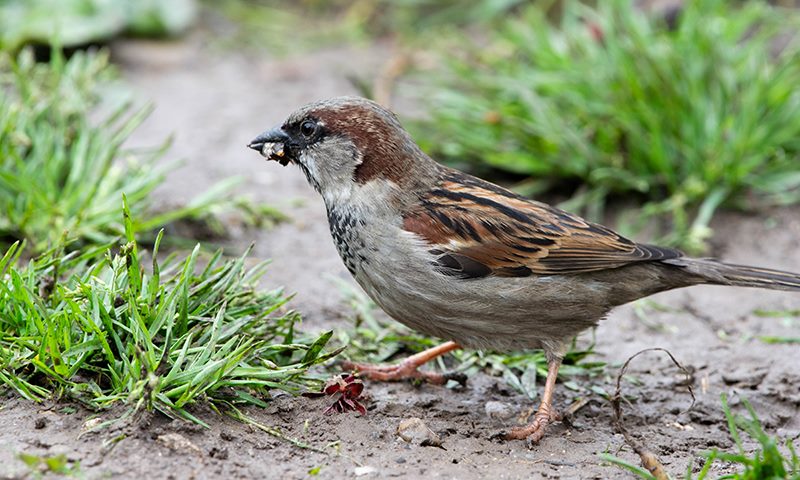
Not all birds want to feed from a feeder. Some will happily search for seed on the ground.
Ground Feeding Wild Birds
Some birds naturally hop along the ground looking, scratching and listening for their next meal. Try sprinkling food directly on the grass or soil near common wild bird covers, such as small bushes, flowerbeds or brush piles.
Recommended seed blend: Wild birds love discovering white millet, insects and worms on the ground. Try sprinkling Pennington Select Birder's Blend Seed & Mealworm Mix on your lawn in an area where you have a clear view of the incoming diners.
Birds to watch: Common ground feeding birds include doves, American Sparrows, towhees, quail, juncos and cardinals. Others may join the party too!

Bring petite hummingbirds to your yard with a nectar feeder.
Nectar Feeders
Some birds prefer flower nectar over seeds, nuts or fruits. Hummingbird feeders offer the sweet liquid in a way that mimics sourcing nectar from flowers. The Pennington 16 oz. Glass Hummingbird Feeder has eight bee-resistant ports that allow hummingbirds easy access to the liquid. Or, consider the larger Pennington 32 oz Decorative Hummingbird Feeder with six nectar ports and perches for birds to stop and rest.
Nectar option: Use the Pennington Ultra ElectroNectar Ready to Use to keep hummers healthy and hydrated without needing to mix a special recipe.
Birds to watch: A filled nectar feeder will bring hummingbirds and orioles into view! Other birds that may explore your nectar feeder include mockingbirds, grosbeaks, tanagers and warblers.
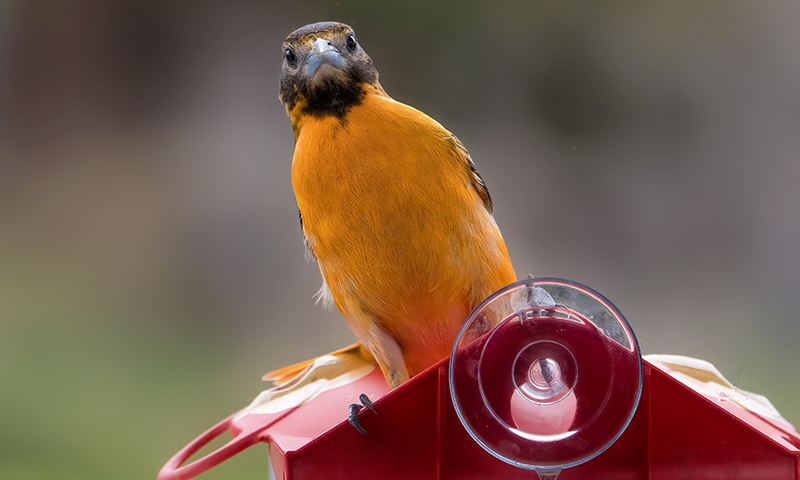
Create space among your bird feeders to avoid traffic collisions.
Birdwatching Tips and Tricks
Once you've chosen the feeders to attract the birds you wish to see, it's time to amplify the experience. Where you place your feeders matters.
Positioning Feeders for Optimal Enjoyment
Like many hobbies, it's easy to expand your birding interest.
If you use more than one feeder, leave a little room in between. Spacing feeders apart gives your wild friends room to fly in and out and eat comfortably with minimal conflicts. After all, nobody likes to squeeze into a busy restaurant, right?
Consider placing various feeders around your property so you can enjoy birdwatching whether you're looking through a window, grilling in the backyard, relaxing in a hammock or taking care of yard work.
Practice Safe Birdwatching from Windows
Bird feeders placed near windows offer optimal viewing from inside your home. However, you need to keep your feathered friends' safety in mind. Clear glass windows (without exterior screens) reflect nearby foliage, feeders, home structures and sky, which can confuse birds in flight and pose a risk for potential injury.
Prevent birds from colliding with your windows by trying one of these ideas:
- Position bird feeders within 3 feet of the window or more than 10 feet away to prevent confusion and collision. You can use a feeder that attaches to the window for close-up viewing.
- Place anti-bird collision window clings, decals or stickers on the glass outside. This breaks up the clear reflective surface, making birds less likely to see the window as flying space.
- Install mosquito screens over the windows. This reduces glass glare and allows you to open the window to enjoy birdsong and fresh air, without inviting any unwanted pests into your home.
- Paint the outside of the window with liquid soap or tempera paint. Try a basic grid pattern of 2-inch by 2-inch squares or flex your artistic skills by painting patterns or a mural.
- Affix sun catchers, metallic paper strips or other reflective items on the outside of the window to keep birds away from the glass. Position them close together to deflect small birds.
- Use dotted tape made for bird window safety. Easily place strips of the tape across the outside of the window to make the glass visible and help prevent bird accidents.
It's also a good idea to keep interior blinds or curtains closed when you're not in the room. These create a solid wall-like appearance in the window, which reduces possible wild bird accidents.
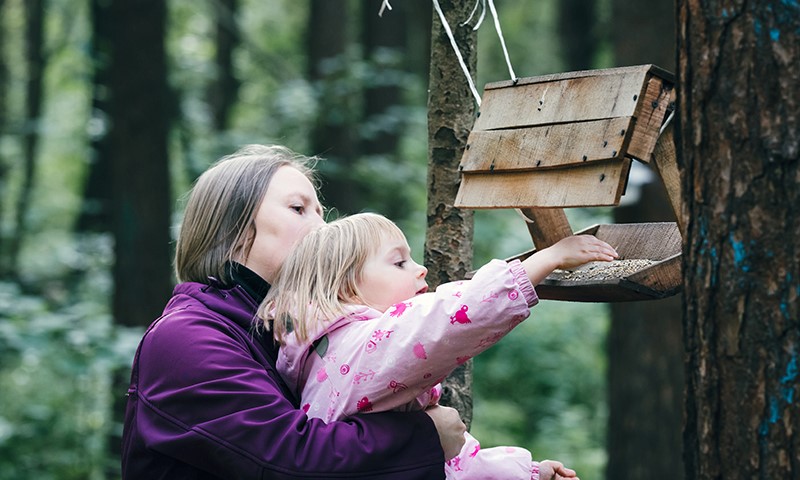
Backyard birding is for all ages!
Elevate Your Birdwatching Hobby
Bring more birds to your yard by placing feeders in areas where you can enjoy the view. Enhance your patio, deck, garden and favorite outdoor spaces. Simply choose the feeders and seed that attract the birds you enjoy watching most, keep them full and have your binoculars ready.
Have questions about feeding birds or even the best type of plants to grow to attract birds? We have answers to help you learn and grow. Our specialty is helping dreams come true. Let us help you nurture your roots
Always read product labels and follow instructions carefully.

